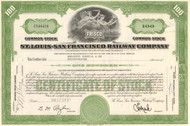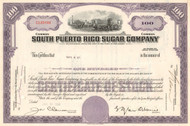Categories
Categories
- Home
- Railroad
- Modern Railroads
- Southern Railway Company 1960's ("Serves the South")
Southern Railway Company 1960's ("Serves the South")
Product Description
Southern Railway Company stock certificate 1960's
Impressive vignette of two classical male figures flanking industrial and passenger train scenes. The picture is highlighted by the company slogan "The Southern serves the South". Issued and cancelled. Dated 1960's.
The Southern Railway was a US class 1 railroad that was based in the Southern United States. It was the product of nearly 150 predecessor lines that were combined, reorganized and recombined beginning in the 1830s, formally becoming the Southern Railway in 1894.
At the end of 1970 Southern operated 6,026 miles (9,698 km) of railroad, not including its Class I subsidiaries AGS, CofG, S&A, CNOTP, GS&F and twelve Class II subsidiaries. That year Southern itself reported 26111 million net ton-miles of revenue freight and 110 million passenger-miles.
It was placed under control of the Norfolk Southern Corporation, along with its rival the Norfolk and Western Railway (N&W), in 1982. The Norfolk Southern Corporation was created in response to the creation of the CSX Corporation (its rail system was later transformed to CSX Transportation in 1986). The Southern Railway was renamed Norfolk Southern Railway in 1990 and continued under that name ever since. Seven years later in 1997 the railroad, now under the name "Norfolk Southern Railway", absorbed the Norfolk and Western Railway ending the Norfolk and Western's existence (the N&W continued to exist as a subsidiary until 1997.)
The pioneering South Carolina Canal and Rail Road Company, Southern's earliest predecessor line and one of the first railroads in the United States, was chartered in December 1827 and ran the nation's first regularly scheduled steam-powered passenger train – the wood-burning Best Friend of Charleston – over a six-mile section out of Charleston, South Carolina, on December 25, 1830. (The Baltimore and Ohio Railroad ran regular passenger service earlier that year.) By 1833, its 136-mile line to Hamburg, South Carolina, was the longest in the world.
As railroad fever struck other Southern states, networks gradually spread across the South and even across the Appalachian Mountains. By 1857 the Memphis and Charleston Railroad was completed to link Charleston, South Carolina, and Memphis, Tennessee, but rail expansion in the South was halted with the start of the Civil War. The Battle of Shiloh, the Siege of Corinth and the Second Battle of Corinth in 1862 were motivated by the importance of the Memphis and Charleston line, the only East-West rail link across the Confederacy.
The Chickamauga Campaign for Chattanooga, Tennessee was also motivated by the importance of its rail connections to the Memphis and Charleston and other lines. Also in 1862 the Richmond and York River Railroad, which operated from the Pamunkey River at West Point, Virginia to Richmond, Virginia, was a major focus of George McClellan's Peninsular Campaign, which culminated in the Seven Days Battles and devastated the tiny rail link. Late in the war, the Richmond and Danville Railroad was the Confederacy's last link to Richmond, and transported Jefferson Davis and his cabinet to Danville, Virginia just before the fall of Richmond in April 1865.
Known as the "First Railroad War," the Civil War left the South's railroads and economy devastated. Most of the railroads, however, were repaired, reorganized and operated again. In the area along the Ohio River and Mississippi River, construction of new railroads continued throughout Reconstruction. The Richmond and Danville System expanded throughout the South during this period, but was overextended, and came upon financial troubles in 1893, when control was lost to financier J.P. Morgan, who reorganized it into the Southern Railway System.
Southern Railway came into existence in 1894 through the combination of the Memphis and Charleston Railroad, the Richmond and Danville system and the East Tennessee, Virginia and Georgia Railroad. The company owned two-thirds of the 4,400 miles of line it operated, and the rest was held through leases, operating agreements and stock ownership. Southern also controlled the Alabama Great Southern and the Georgia Southern and Florida, which operated separately, and it had an interest in the Central of Georgia.
Southern's first president, Samuel Spencer, drew more lines into Southern's core system. During his 12-year term, the railway built new shops at Knoxville, Tennessee, and Atlanta, Georgia and purchased more equipment. He moved the company's service away from an agricultural dependence on tobacco and cotton and centered its efforts on diversifying traffic and industrial development. Spencer was killed in a train wreck in 1906.
The Central of Georgia became part of the system in 1963, and the former Norfolk Southern Railway was acquired in 1974. Despite these small acquisitions, the Southern disdained the merger trend when it swept the railroad industry in the 1960s, choosing to remain a regional carrier. In 1978 President L. Stanley Crane said the refusal to add routes through merger was a mistake, especially the decision not to add a connecting route to Chicago.
In response to the creation of CSX in 1980, the Southern Railway merged with Norfolk and Western Railway to form the Norfolk Southern Railway in 1982, further consolidating railroads in the eastern half of the United States. Two railroads that would have offered access to Chicago, the Monon Railroad and the Chicago and Eastern Illinois Railroad, which both went to Southern's competitor, the Louisville and Nashville Railroad.
A decade later Crane tried to rectify the situation by merging with the Illinois Central Railroad. When that failed, he petitioned the Interstate Commerce Commission to give Southern the old Monon routes and the old Atlantic Coast Line route from Jacksonville to Tampa by way of Orlando among other properties as a condition of the I.C.C.'s approval of the Seaboard Coast Line - Chessie System merger in 1979. While the request was supported by the I.C.C.'s Enforcement Bureau, it was ultimately unsuccessful.
 Loading... Please wait...
Loading... Please wait... 








